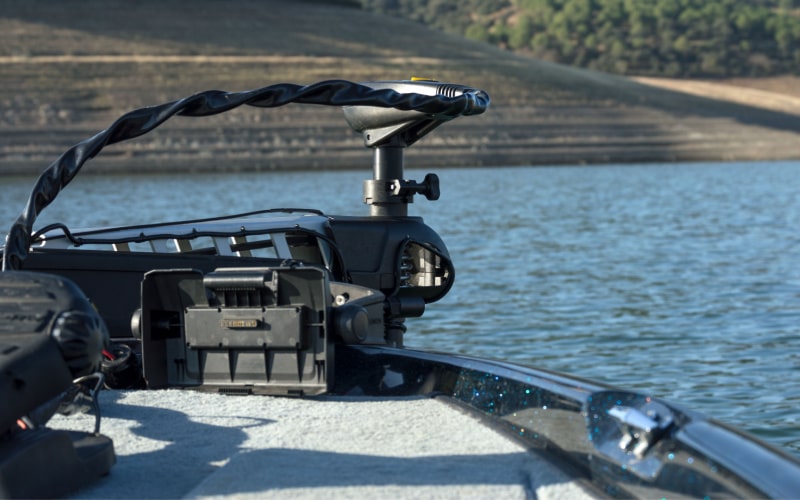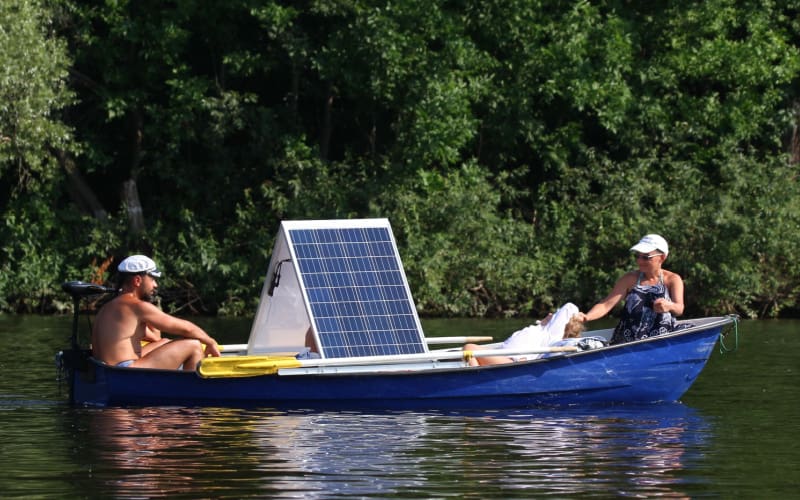Many people wonder about putting trolling motors on canoes. After all, canoes are ideal fishing vessels in many situations, but the fact that they are human-powered can be a downside.
In fact, many people do put trolling motors on canoes. Before you try it, though, it’s important to know what you’re doing. Here’s what you need to know to put a trolling motor on your canoe.
Table of Contents
Where Do You Mount a Trolling Motor on a Canoe?

There are two locations where you can easily mount a trolling motor on a canoe. These are: the bow and the transom. Where you mount your motor will depend on several factors, including:
- How you plan to use your trolling motor
- The exact setup of your canoe
- Where you want to sit to use the trolling motor
- How you plan to distribute the weight in your canoe
How Do You Mount a Trolling Motor on a Canoe?
Before you mount your trolling motor, you will need to choose the trolling motor that is right for you. We have some guidelines for getting one that is the right size outlined below or you can ask at your local fishing shop.
You should also check to see if the manufacturer of either your canoe or your trolling motor makes trolling motor mounts for your watercraft. Having a mount can make it a lot easier to attach your trolling motor to your canoe, though making your own is not hard.
Finally, you will need to make sure that you have the right tools and parts to mount your trolling motor. Watch the videos below and read our instructions, then check your tools. Different canoes will require different tools, so be sure you have the right ones before you start.
Bow Mount

Most serious anglers prefer bow mounts to transom mounts. Here’s how to get your trolling motor mounted on your bow.
Start by measuring where the mount should go. Its screws will need to go through the deck of your canoe but not its hull. Mark where you will need to drill holes onto the deck.
Use the mount base as a template when you’re making these marks. After all, you don’t want to find out later that your holes are not in the right place!
Next, drill your holes. Make them approximately ¼” deep. Clear out any sawdust or debris from the holes.
Put a bolt through each hole in your mount’s base. Use a washer under each mount base for added grip and stability.
Now, put the mount base into the holes that you already drilled. The mount base needs to be level with the deck of your canoe when it is sitting in the holes. If it is not, drill again to adjust the holes so that it is level.
Once it is level, thread a washer onto each bolt. Attach the motor to the mount by following the manufacturer’s instructions.
When you’re finished, check to ensure that the entire setup is secure. Make sure that the motor is securely attached to the mount and the mount to your canoe.
Finally, make sure that the trolling motor sits far enough below the water to work well but not so far that it is awkward to run. This is usually between 5 and 12 inches, depending on your preferred fishing position, the length of your propeller blades, and your personal preference.
You can see what a mount like this looks like when you watch the video below. Let this video inspire you to improve your kayak so you can enjoy it maximally while out on the water.
Transom Mount

Trolling motors on the transom are much more popular among people who like to canoe than bow-mounted versions. That’s because the transom-mounted motors cost less and give plenty of control for a small boat, like a canoe.
To mount a trolling motor on the transom of your canoe, you can usually use the clamps that come with a transom-mounted trolling motor. Note that every manufacturer will have clamps that operate slightly differently.
Most of the time, all you need to do is turn the clamps counterclockwise. This opens them. Make sure that you have plenty of opening space to get the trolling motor on your boat effectively.
Place the trolling motor as close as you can to the center of the stern. Then, turn the clamps clockwise as far as you can. This closes them and keeps the trolling motor attached to the back of your boat.
If you don’t like to clamp your trolling motor to your boat or you want to mount a trolling motor to the transom that does not have a clamp, here’s what you can do. This is also useful if you want the trolling motor on the back of your boat but not perfectly centered on the stern.
Start by creating a piece that goes across the canoe behind your seat. This will need to be measured and built using 2x4s, based on the size and shape of your particular canoe.
This should stick approximately 6 inches out on the side of the boat where you want your trolling motor to sit.
Find a mounting plate for your trolling motor. This can be branded or generic, as long as it fits your trolling motor and attaches to it properly.
Using screws and washers, attach the trolling motor mount to the flat piece that you made to go behind your seat. Test this to make sure that it is entirely secure and that you can reach your trolling motor from your seat.
You can see this process outlined in the video below. You will learn how to measure your canoe to make the mounting bracket that you need so you can get your trolling motor where you want it.
FAQ
These are some of the most common questions that we hear about putting trolling motors on canoes.
Is it Legal to Put a Trolling Motor on a Canoe?

The short answer is that yes, it is legal to mount a trolling motor on a canoe. However, once you have mounted the motor, you will need to get both registration and a title for your canoe.
Carry these with you at all times when you’re out on the water, because safety officers can always ask you for them. Depending on where you live, you might also need to put registration numbers on your kayak. Make sure you follow state laws regarding these numbers.
What Kind of Trolling Motor Should I Put on My Canoe?
Most people choose to put an electric trolling motor on their canoes, though there are gas-powered options, too. In general, eclectic trolling motors are cheaper to run and less dangerous to use.
If you do choose an electric trolling motor, you will need to make sure that you have space for batteries on your boat. You’ll likely only need one 12-volt marine battery, as well as the wires that run from the battery to the trolling motor.
It will take up approximately one square foot of space. They weigh anywhere from 12 to 70 pounds, depending on their capacity and internal chemistry.
How Fast Will a Canoe Go With a Trolling Motor?

Trolling motors are only made to go between 3 and 5 miles per hour. It doesn’t matter how small the boat is or how big the trolling motor is. While larger motors may have more thrust, they will not make you go a whole lot faster.
Trolling motors are designed for slow speeds because that’s what you need when you’re trolling for fish. If you want to go faster than that, consider a different kind of motor. Just make sure you never mount a motor that is too powerful on your canoe because you could damage it.
What Size Trolling Motor Do I Need for a Canoe?
The smallest trolling motors will be plenty large enough for use on your canoe. These are made for small-sized traditional boats, so they will have plenty of thrust for your canoe. Don’t get a trolling motor that is too big for your canoe because you could damage your watercraft.
If you have an extra-long canoe or a canoe made for multiple people, you may be able to use a larger trolling motor. However, you will need to make sure that your canoe can handle the weight of the large motor, as well as the batteries you will need to have on board to power it.
Conclusion
Adding a trolling motor to a canoe can make your days out on the water even better than they already are. When you can easily cruise for fish, you may catch more than you ever have before. The trolling motor also allows you to take your canoe farther than ever before.
Once you buy your new trolling motor and get it mounted, you’ll be able to enjoy the water in new ways. Have fun, stay safe, and enjoy every minute you spend in your canoe!

I created this site to help people – to help you – with your boat problems. Instead of helping one person at a time, I want this website to be the “one-stop-shop” for everyone’s boating concerns. Read more.

